A cup fell to the ground
With a sound clearly heard.
As space was pulverised,
The mad mind came to a stop.
Later life
Xuyun worked tirelessly as a bodhisattva, teaching precepts, explaining sutras, and restoring old temples. He worked throughout Asia, creating a following across Burma, Thailand, Malaya, and Vietnam, as well as Tibet and China. He remained in China during World War II. In the winter of 1942, Xuyun held a "Protect the Nation, Quell the Disaster, Mahākaruṇā Dharma Assembly" that lasted over three months in Chongqing, the capital of China at that time. He stayed after the rise of the People's Republic of China (PRC) to support the Buddhist communities rather than retreat to the safety of Hong Kong or Taiwan.
In the spring of 1951, Xuyun and twenty-five monks were accused of hiding weapons and treasure. They were arrested and tortured in Yunmen Monastery (simplified Chinese :云门寺; traditional Chinese :雲門寺; pinyin :Yúnmén Sì) in Shaoguan, Guangdong province. Some of the monks were tortured to death or suffered broken bones. Xuyun endured several beatings during the interrogations, resulting in fractures to his rib cage. He closed his eyes and would not talk, eat, or drink, and stayed in the samādhi for nine days. During this time, his attendants Fayun and Kuanchun waited on him. Several of his works on scriptural commentary were also destroyed. Li Jishen, who was Vice President of the PRC at the time, informed and sought help from the then Premier of the PRC, Zhou Enlai, who put an end to the monks' detention after three months. This incident later became known as the "Yunmen Incident." [14] [15]
In 1953, with Dharma Master Yuan Ying and others, Xuyun formed the Chinese Buddhist Association at Guangji (Extensive Aid) Monastery where he was Honorary President. The following resolutions were proposed to the government:
- In all places, further destruction of monasteries and temples, the desecration of images, and the burning of sutras shall immediately cease;
- Forcing bhikshus and bhikshunis to leave their monastic orders will not be tolerated; and
- All monastery property shall be returned forthwith, and enough arable acreage should be returned to the Sangha so as to make the monasteries self-supporting.
The petition was approved. Xuyun then represented the Association in receiving three gifts from a Buddhist delegation from Sri Lanka. [16] He also responded to the invitation of Dharma Master Nan Tong to head another Dharma assembly at Lang Shan Monastery, where several thousand people from all over took refuge in Triple Gems. He returned to Shanghai in the third lunar month, and the next month received a telegram from Beijing requesting his presence in the capital. After arriving, he stayed at Guangji Monastery. Representatives of various Buddhist groups also were present, and the Chinese Buddhist Association was officially inaugurated. After a plenary meeting in which important policies were decided, some monks suggested to him some changes to precepts and rules. Xuyun then scolded them and wrote an essay about the manifestation of the Dharma Ending Age. [17] [18]
Death
Xuyun became ill in the summer of 1959 and died on 13 October of the same year. [19]
Significance
In 1953, the Chinese Buddhist Association was established at a meeting with 121 delegates in Beijing. The meeting also elected a chairman, four honorary chairmen, seven vice-chairmen, a secretary general, three deputy secretaries-general, eighteen members of a standing committee, and ninety-three directors. The four elected honorary chairmen were the Dalai Lama, the Panchen Lama, the Grand Lama of Inner Mongolia, and Xuyun himself. [20]
Publications
- Empty Cloud: The Autobiography of the Chinese Zen Master Xu Yun [21]
Notes
- ↑ Heine, Steven; Wright, Dale Steward (2010), Zen Masters, Oxford: Oxford University Press, p. 92. ISBN 9780199777181
- ↑ Buswell, Robert Jr; Lopez, Donald S. Jr., eds. (2013). "Xuyun", in Princeton Dictionary of Buddhism. Princeton, NJ: Princeton University Press. p. 1017. ISBN 9780691157863.
- ↑ "虛雲老和尚畫傳集 上宣下化老和尚著述 A Pictorial Biography of the Venerable Master Hsu Yun composed by the Venerable Master Hsuan Hua". Drbachinese.org. Retrieved 2012-02-27.
- ↑ "虛雲老和尚畫傳集 上宣下化老和尚著述 A Pictorial Biography of the Venerable Master Hsu Yun composed by the Venerable Master Hsuan Hua". Drbachinese.org. Retrieved 2012-02-27.
- ↑ "虛雲老和尚畫傳集 上宣下化老和尚著述 A Pictorial Biography of the Venerable Master Hsu Yun composed by the Venerable Master Hsuan Hua". Drbachinese.org. Retrieved 2012-02-27.
- ↑ "虛雲老和尚畫傳集 上宣下化老和尚著述 A Pictorial Biography of the Venerable Master Hsu Yun composed by the Venerable Master Hsuan Hua". Drbachinese.org. Retrieved 2012-02-27.
- 1 2 "虛雲老和尚畫傳集 上宣下化老和尚著述 A Pictorial Biography of the Venerable Master Hsu Yun composed by the Venerable Master Hsuan Hua". Drbachinese.org. Retrieved 2012-02-27.
- ↑ "Song Of The Skin Bag". www.dharmasite.net.
- ↑ "虛雲老和尚畫傳集 上宣下化老和尚著述 A Pictorial Biography of the Venerable Master Hsu Yun composed by the Venerable Master Hsuan Hua". Drbachinese.org. Retrieved 2012-02-27.
- ↑ "虛雲老和尚畫傳集 上宣下化老和尚著述 A Pictorial Biography of the Venerable Master Hsu Yun composed by the Venerable Master Hsuan Hua". Drbachinese.org. Retrieved 2012-02-27.
- ↑ "虛雲老和尚畫傳集 上宣下化老和尚著述 A Pictorial Biography of the Venerable Master Hsu Yun composed by the Venerable Master Hsuan Hua". Drbachinese.org. Retrieved 2012-02-27.
- ↑ "虛雲老和尚畫傳集 上宣下化老和尚著述 A Pictorial Biography of the Venerable Master Hsu Yun composed by the Venerable Master Hsuan Hua". Drbachinese.org. Retrieved 2012-02-27.
- ↑ "虛雲老和尚畫傳集 上宣下化老和尚著述 A Pictorial Biography of the Venerable Master Hsu Yun composed by the Venerable Master Hsuan Hua". Drbachinese.org. Retrieved 2012-02-27.
- ↑ Xu Yun (Author); Luk, Charles (Translator); Hunn, Richard (Revised & edited): "Empty Cloud: The Autobiography of the Chinese Zen Master Xu Yun", pages 138-140. Element Books, 1988, ISBN 1-85230-031-0
- ↑ Venerable Master Hsuan Hua (Composed by); Buddhist Text Translation Society/Dharma Realm Buddhist University (Translator): "A Pictorial Biography of the Venerable Master Hsu Yun, Vol. 1", pages 433-435. Dharma Realm Buddhist University, 1983, ISBN 0-88139-008-9
- ↑ "虛雲老和尚畫傳 上宣下化老和尚著述 A Pictorial Biography of the Venerable Master Hsu Yun composed by the Venerable Master Hsuan Hua". Drbachinese.org. Retrieved 2012-02-27.
- ↑ "虛雲和尚年譜" [Chronology of Monk Xuyun] (in Chinese).
- ↑ Ch'en, Kenneth (1964). Buddhism in China : A Historical Survey. Princeton: Princeton University Press. pp. 463–4. ISBN 0691000158.
- ↑ "虛雲老和尚畫傳 上宣下化老和尚著述 A Pictorial Biography of the Venerable Master Hsu Yun composed by the Venerable Master Hsuan Hua". Drbachinese.org. Retrieved 2012-02-27.
- ↑ Holmes, Welch (1961). "Buddhism Under the Communists", China Quarterly, No.6, Apr-June 1961, pp. 1-14.
- ↑ Xuyun (1988). Empty Cloud : the autobiography of the Chinese Zen Master, Xu-Yun. Lu, Kʻuan Yü, 1898-, Hunn, Richard. Shaftesbury, Eng.: Element Books. ISBN 1-85230-031-0. OCLC 24585170.
Related Research Articles

Fo Guang Shan Hsi Lai Temple is a mountain monastery in the northern Puente Hills, Hacienda Heights, Los Angeles County, California. The name Hsi Lai means "coming west".

Hsin Ting is a Buddhist monk from Taiwan and senior elder of the Fo Guang Shan order. He served as the third abbot and director of the order from 1997 to 2005. He served as acting abbot for three years after the death of his predecessor, Hsin Ping, in 1995. From 2004 to 2010, Hsin Ting served as the president of Buddha's Light International Association. Hsin Ting was later appointed the abbot of Tai Hua Temple in Bangkok, Thailand, assisting in overseeing the construction project for Fo Guang Shan's satellite branch temple in Southeast Asia.

Baizhang Huaihai (720–814) was a Zen master during the Tang dynasty. A native of Fuzhou, he was a dharma heir of Mazu Daoyi. Baizhang's students included Huangbo, Linji and Puhua.
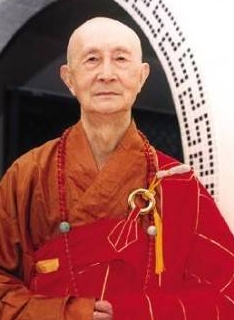
Yin Shun was a Chinese Buddhist monk and scholar in the tradition of Chinese Mahayana Buddhism. Though he was particularly trained in the Three Treatise school, he was an advocate of the One Vehicle as the ultimate and universal perspective of Buddhahood for all, and as such included all schools of Buddha Dharma, including the Five Vehicles and the Three Vehicles, within the meaning of the Mahayana as the One Vehicle. Yin Shun's research helped bring forth the ideal of "Humanistic" (human-realm) Buddhism, a leading mainstream Buddhist philosophy studied and upheld by many practitioners. His work also regenerated the interests in the long-ignored Āgamas among Chinese Buddhist society and his ideas are echoed by the American Theravadin teacher Bhikkhu Bodhi. As a contemporary master, he was most popularly known as the mentor of Cheng Yen, the founder of Buddhist Tzu Chi Charity Foundation, as well as the teacher to several other prominent monastics.
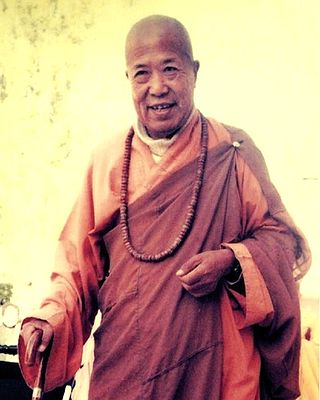
Hsuan Hua, also known as An Tzu, Tu Lun and Master Hua by his Western disciples, was a Chinese monk of Chan Buddhism and a contributing figure in bringing Chinese Buddhism to the United States in the late 20th century.

Daoxuan was an eminent Tang dynasty Chinese Buddhist monk. He is perhaps best known as the patriarch of the four-part Vinaya school. Daoxuan wrote both the Continued Biographies of Eminent Monks and the Standard Design for Buddhist Temple Construction. Legends retold in his biographies also associate him to a relic of the Buddha which came to be called Daoxuan's tooth, one of the four tooth relics enshrined in the capital of Chang'an during the Tang dynasty. He is said to have received the relic from Nezha, a divinity associated with Indra.

The City of Ten Thousand Buddhas is an international Buddhist community and monastery founded by Hsuan Hua, an important figure in Western Buddhism. It is one of the first Chan Buddhist temples in the United States, and one of the largest Buddhist communities in the Western Hemisphere.

The Śūraṅgama Sūtra is a Mahayana Buddhist sutra that has been especially influential on Korean Buddhism and Chinese Buddhism. It was particularly important for Zen/Chan Buddhism. The doctrinal outlook of the Śūraṅgama Sūtra is that of Buddha-nature, Yogacara thought, and esoteric Buddhism.
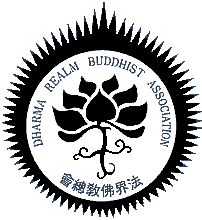
The Dharma Realm Buddhist Association is an international, non-profit Buddhist organization founded by the Venerable Master Hsuan Hua in 1959 to bring the orthodox teachings of the Buddha to the entire world. DRBA has branch monasteries in many countries and cities, including San Francisco, Los Angeles, Seattle, and Vancouver, as well as in Malaysia, Taiwan, Hong Kong, and Australia.
Venerable Master Fayun (1933–2003) was a Chinese Buddhist monk and thirteenth generation successor in the Yunmen lineage of the Chan (Zen) school of Chinese Buddhism.

The Pagoda of Bailin Temple, is located in Zhao County, Hebei. It is an octagonal-based brick Chinese pagoda built in 1330 during the reign of Emperor Wenzong, ruler of the Mongol-led Yuan Dynasty.
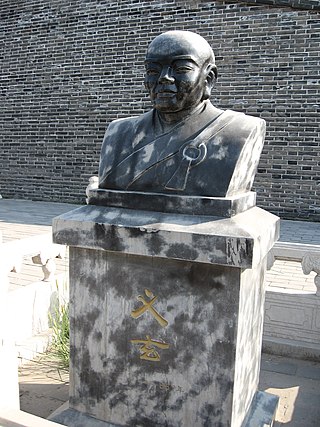
The Línjì school is a school of Chan Buddhism named after Linji Yixuan. It took prominence in Song China (960–1279), spread to Japan as the Rinzai school and influenced the nine mountain schools of Korean Seon.

The Shurangama or Śūraṅgama mantra is a dhāraṇī or long mantra of Buddhist practice in East Asia. Although relatively unknown in modern Tibet, there are several Śūraṅgama Mantra texts in the Tibetan Buddhist canon. It has strong associations with the Chinese Chan Buddhist tradition.
The Five Houses of Chán were the five major schools of Chan Buddhism that originated during Tang China. Although at the time they were not considered formal schools or sects of Buddhism, they are now regarded as important schools in the history of Chán Buddhism. Most Chán lineages throughout Asia and the rest of the world originally grew from or were heavily influenced by the original five houses of Chán.
Hua Tou is part of a form of Buddhist meditation known as Gongfu 工夫 common in the teachings of Chan Buddhism, Korean Seon and Rinzai Zen. Hua Tou can be translated as 'word head', 'head of speech' or 'point beyond which speech exhausts itself'. A Hua Tou can be a short phrase that is used as a subject of meditation to focus the mind.
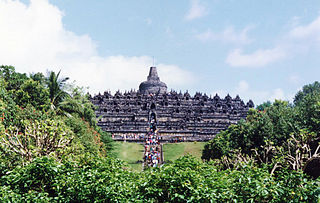
Ashin Jinarakkhita, born Tee Boan-an was an Indonesian-born Chinese who revived Buddhism in Indonesia. He was also known as Bhante Ashin, Tizheng Lao Heshang 體正老和尚, Teh-ching, Sukong 師公 (Grandmaster), and The Flying Monk.
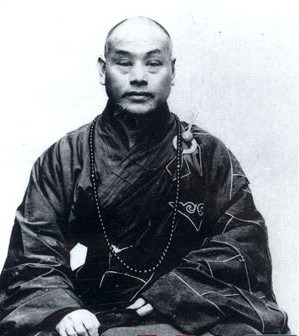
Yuanying was a Chinese Chan Buddhist master and the first Venerable Master of the Buddhist Association of China.
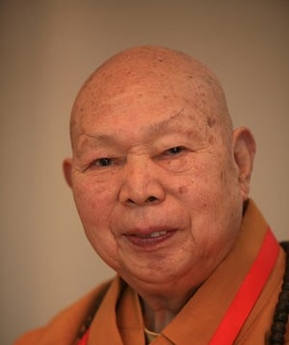
Yicheng was a Chinese Buddhist monk, Chan master and religious leader. Yicheng was best known as Venerable Master of the Buddhist Association of China.

The Zhenru Chan Temple is a Chan Buddhist temple located on the southwestern hillside of Mount Yunju in Yongxiu County, Jiangxi, China. Zhenru Chan Temple is the cradle of Caodong school in Chinese Buddhism. The temple has been burned down and rebuilt several times due to wars and fires. The present version was completed in the 1950s.

Hsu Yun Temple (also Xuyun; 虛雲禪寺 ; 虚云禅寺 ; is a temple of the Xuyun branch of the Linji school of Chán Buddhism in Honolulu, Hawaii.
References
- Campo, Daniela (2017). Chan Master Xuyun, the Embodiment of an Ideal, the Transmission of a Model. In David Ownby, Vincent Goossaert, Ji Zhe, Making Saints in Modern China. Oxford University Press. pp. 102–136. ISBN 978-0-19-049456-8.
- Gauci, Damian, John (2011). Chan-Pure Land: An Interpretation of Xu Yun's (1840-1959) Oral Instructions, Chung-Hwa Buddhist Journal 24, 105-120
- Huimin Bhiksu (2009). An Inquiry Into Master Xuyun’s Experiences of Long-dwelling in Samadhi, Chung-Hwa Buddhist Journal 22, 45-68
- Hunn, Richard (ed.), translated by Charles Luk (1974). Empty Cloud: the Autobiography of the Chinese Zen Master Hsu Yun. Rochester: Empty Cloud Press. Shaftesbury: Element Books, 1988 (revised)
- Kʻuan Yü Lu (Charles Luk) (1964). "Master Hsu Yun Brief Biography", The Mountain Path, Vol. 1, October 1964, No. 4
- Kʻuan Yü Lu (Charles Luk) (1961). Ch'an and Zen teaching, London : Rider. OCLC 459708159
- Kʻuan Yü Lu; Xuyun (1993). Master Hsu Yun's discourses and dharma words, Hong Kong : H. K. Buddhist book distributor.
- Hsuan Hua (1983,1985). A Pictorial Biography of the Venerable Master Hsu Yun - Vol.1 and Vol.2 (2nd edition 2003). Burlingame, Calif.: Buddhist Text Translation Society, Dharma Realm Buddhist Univ. ISBN 0881394858
- Sakya, Jy Din (1996). Empty Cloud: The teachings of Xu Yun. A remembrance of the Great Chinese Zen Master, Hong Kong : H. K. Buddhist book distributor
External links
- There are two institutions under the name "Zen Buddhist Order of Hsu Yun": one at hsuyun.org and another at zatma.org
- List of books on the life and teachings of Master Hsu Yun.
- Testimonies of awakening
- 虛雲和尚年譜
- Master Xuyun Memorial Photographic Library
- Teachings by Master Xu Yun on “Huatou”-style Practice in Chan
Xuyun | |||||||||||||||||||||||
|---|---|---|---|---|---|---|---|---|---|---|---|---|---|---|---|---|---|---|---|---|---|---|---|
虛雲 | |||||||||||||||||||||||
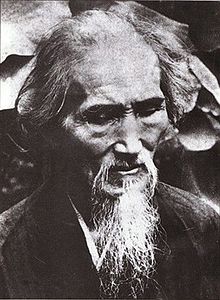 Xuyun | |||||||||||||||||||||||
| Title | Honorary President of the Buddhist Association of China | ||||||||||||||||||||||
| Personal | |||||||||||||||||||||||
| Born | 5 September 1840 (reputedly) | ||||||||||||||||||||||
| Died | 13 October 1959 (Aged 119 years, 48 days) Zhenru Temple, Jiangxi, China | ||||||||||||||||||||||
| Religion | Chan Buddhism | ||||||||||||||||||||||
| Nationality | Chinese | ||||||||||||||||||||||
| School | Weiyang school Linji school Caodong school Yunmen school Fayan school | ||||||||||||||||||||||
| Lineage | 8th generation of Weiyang school 43rd generation of Linji school 8th generation of Fayan school 47th generation of Caodong school 12th generation of Yunmen school | ||||||||||||||||||||||
| Organization | |||||||||||||||||||||||
| Temple | Zhenru Temple (Jiangxi) | ||||||||||||||||||||||
| Senior posting | |||||||||||||||||||||||
| Teacher | Changkai Yung Ching Miaolian | ||||||||||||||||||||||
Students
| |||||||||||||||||||||||
| Chinese name | |||||||||||||||||||||||
| Traditional Chinese | 虛雲 | ||||||||||||||||||||||
| Simplified Chinese | 虚云 | ||||||||||||||||||||||
| |||||||||||||||||||||||
| Main articles | |||||||||||||||||||||||||
|---|---|---|---|---|---|---|---|---|---|---|---|---|---|---|---|---|---|---|---|---|---|---|---|---|---|
| Doctrinal background | |||||||||||||||||||||||||
| Influential Sutras | |||||||||||||||||||||||||
| Teachings | |||||||||||||||||||||||||
| Practice | |||||||||||||||||||||||||
| Persons |
| ||||||||||||||||||||||||
| Chinese Chán |
| ||||||||||||||||||||||||
| Japanese Zen |
| ||||||||||||||||||||||||
| Korean Seon |
| ||||||||||||||||||||||||
| Vietnamese Thiền |
| ||||||||||||||||||||||||
| USA Zen |
| ||||||||||||||||||||||||
| European Zen |
| ||||||||||||||||||||||||
| Hierarchy and titles |
| ||||||||||||||||||||||||
| Temples |
| ||||||||||||||||||||||||
| Zen literature | |||||||||||||||||||||||||
| Cultural influence | |||||||||||||||||||||||||
| Related schools | |||||||||||||||||||||||||
| Academic research | |||||||||||||||||||||||||